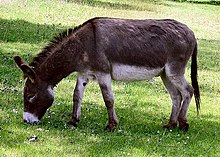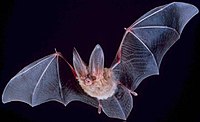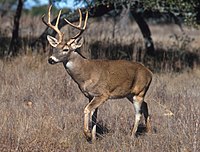Pegasoferae
The division of living beings into systematics is a continuous subject of research. Different systematic classifications exist side by side and one after the other. The taxon treated here has become obsolete due to new research or is not part of the group systematics presented in the German-language Wikipedia.

The Pegasoferae are a hypothetical taxon within the mammals (Mammalia), which was proposed for the first time in June 2006 by Hidenori Nishihara , Masami Hasegawa and Norihiro Okada on the basis of a molecular biological analysis. It is a grouping of the ferae ( predators and pangolins ), the odd ungulates (Perissodactyla) and the bats (Chiroptera) in a common systematic group. It thus offers an alternative to the hypothesis of the Fereuungulata , which has been accepted as plausible up to now , the combination of the Ferae and odd-toed ungulates with the Cetartiodactyla ( even-toed ungulates and whales ).
Brief description of the groups of animals considered
Due to the very different ways of life and combinations of characteristics of the animal groups united within the Pegasoferae, a generally valid description of characteristics is not possible, the combination is only based on similarities in the genetic material. In the following, the considered taxa and the cetartiodactyla, which are regarded as sister groups, are briefly described; a detailed description can be found in the corresponding articles:

Ferae
The Ferae consist of the species-poor group of pangolins (Pholidota) and the shape-rich predators (Carnivora). With the exception of the seals, these are four-legged land animals that are widespread worldwide and mostly specialize in a predatory way of life (the giant panda , for example, is an exception ). The pangolins are highly specialized ant and termite eaters, most of the predators carnivores and fish eaters. The relationship between these two groups of animals, which are kept as orders, is largely confirmed, although the pangolins are also often classified as being related to the secondary animals .

Odd-toed ungulates
The unpaired ungulates (Perissodactyla) are a group of large herbivores. The horses in particular are highly specialized runners who have adapted to the steppe landscapes. The tapirs and rhinos also belong to this group . As a characteristic feature of all unpaired ungulates, the main axis of both the front and rear feet runs through the central ray, the third toe is accordingly the largest in all species.

Bats
The bats are the only mammals that are capable of active flight. According to the requirements of this way of life, their extremities are modified and equipped with a flight membrane. They feed partly on insects ( bats ) and partly on fruits ( flying foxes ). After rodents , they represent the most species-rich order of mammals.

Cetartiodactyla
The Cetartiodactyla are made up of the pair of ungulates (Artiodactyla) and the whales (Cetacea), which are combined into a monophyletic taxon due to both morphological and molecular biological characteristics. The artifacts are, similar to the odd-toed ungulates, large, four-legged herbivores in which the toes have developed into hooves due to an adaptation to an ongoing way of life, with the central axis of one leg lying between the third and fourth toe. The whales, on the other hand, represent a group of animals that have fully adapted to life in the sea ( marine mammals ). This group includes both hunting carnivores ( toothed whales feed on fish, octopus, mammals and other marine animals) and plankton filter feeders ( baleen whales ). The grouping of the whales into the relatives of the artifacts takes place mainly on the basis of paleontological finds, within the artifacts the hippos are the closest relatives of the whales.
method
Background: structure and function of the genetic elements used
As a basis for the compilation of the pegasoferae, short sections of the genome , so-called retroposons , of representatives of all orders within mammals were compared and evaluated. Retroposons are a special form of transposons (jumping genes) that are contained in the genome and are characterized by the fact that they can only be duplicated with the help of reverse transcription . So far, no mechanism is known that could cause a removal ( reversion ) of a retroposon once integrated in the genome. In addition, the multiple independent incorporation ( insertion ) of a homologous retroposon at the same location within a genome is ruled out in different animal groups. For this reason, retroposons are not susceptible to homoplasia or convergences , i.e. characteristics that have developed independently several times, and represent a stable element within the genome on which phylogenetic studies with high informative value can be carried out.
For the investigation of Nishihara et al. a. were long interspersed nuclear elements (LINE) of the type L1 used all orders of mammals to representatives. The L1 elements are among the best-researched retroposons and make up about 16% of the total genome in humans. Based on their base pairing and especially the arrangement of the nucleotides at the so-called 3 'end, they are divided into over 50 different types. They also differ in their length, which averages around six k bp (6000 base pairs) but can vary by several hundred base pairs. The variation is attributed to breaks in the replication of the DNA during the incorporation of the elements into the genome. Since the individual L1 elements are actually unique in their structure and their position in the genome, homoplasia is completely excluded.
Selection and comparison of the retroposons
To illustrate the phylogenetic relationships within mammals, sequences of the genome of representatives of all mammalian orders with the exception of pangolins were compared with one another ( alignment ) and the most plausible result was obtained using the bootstrap method. In doing so, the working group concentrated on the L1 elements described and compared a total of 192 loci ( gene locations) with one another, which they found in a previous in silico screening when comparing already known gene sequences of humans ( Homo sapiens ), the house mouse ( Mus musculus ), the domestic dog ( Canis lupus familiaris ) and the domestic cattle ( Bos taurus taurus ).
Of these, 44 loci were recognized and used as evidence of a phylogenetic relationship at the level of the orders .
Result
The Nishihara et al. a. Hypothesis developed in 2006 confirms the general large systematics within the higher mammals with the Afrotheria , Xenarthra , Euarchontoglires and Laurasiatheria . The studies also support the scrotifera taxon . Within this, however, their results contradict the taxon of the Fereuungulata , which has hitherto been recognized as plausible , in that instead of the Cetartiodactyla, the bats are grouped as a sister group of the odd-toed ungulates and ferae ( Zooamata ) and with them form the taxon Pegasoferae. The Cetartiodactyla are considered a sister group of the Pegasoferae:
| Laurasiatheria |
|
||||||||||||||||||||||||
|
|
The grouping of the Euungulata , which is often still to be found in the classical systematics , in which the odd-toed ungulates, even- toed ungulates and whales form a taxon, was completely rejected . The group of ungulates (ungulata), which, in addition to the orders already mentioned, should also include aardvarks , elephants , manatees and hyrax and which is based exclusively on morphological characteristics, is also excluded.
Also with the placement of the bats, the investigations based on morphological features are not supported, which classify them in the relationship of the primates , giant gliders and shrews and thus in the archonta instead of the Laurasiatheria. This cannot be confirmed on a molecular basis; here the bats have been considered either as a sister group of the Fereuungulata or as a sister group of the insectivores (Eulipotyphla), with which they then form the common taxon of Insectiphillia .
Morphological and paleontological findings
On a morphological basis, it is very difficult or impossible to confirm all the taxa within mammals that have been formed on the basis of molecular genetic analyzes. Especially within the Laurasiatheria, in which the Pegasoferae are settled, the morphological view contradicts the knowledge of molecular biology. One problem of classification is the two classically grouped ungulates (ungulata), the ungulates and ungulates. Both share a number of common features that are now considered to be convergent . Above all, this includes the development of the hooves as a reduction and adaptation phenomenon of the four limbs, especially the finger and toe rays .
The molecular-biological find cannot be supported palaeontologically either, since the early mammalian evolution led to rapid radiation of the various mammalian forms. The first representatives of the different mammalian orders can be found early on, but transitional forms are only very rarely available. This applies to all groupings within the Laurasiatheria with the exception of the Cetartiodactyla, where finds of early whales allow a clear assignment as sister group of the ungulates .
Naming
The name Pegasoferae is made up of the already established name Ferae ( Latin : wild animals) for the taxon consisting of predatory and pangolin and the root word Pegaso-. Since the other two groups of Pegasoferae are the flying bats and the odd-toed ungulates, in which the horses make up the largest proportion, it refers to the Pegasus from Greek mythology. It is a flying horse, suggested the name by Masami Hasegawa.
literature
The text is essentially based on the publication
- Hidenori Nishihara, Masami Hasegawa, Norihiro Okada: Pegasoferae, an unexpected mammalian clade revealed by tracking ancient retroposon insertions. In: Proceedings of the National Academy of Sciences . 103, 2006, pp. 9929–9934 ( full text, PDF available )
The following sources were also used for the methodological part and the taxonomic presentation:
- PD Waddell, Y. Cao, J. Hauf, M. Hasegawa: Using novel phylogenetic methods to evaluate mammalian mtDNA, including amino acid invariant sites LogDet plus site stripping, to detect internal conflicts in the data, with special reference to the positions of hedgehog , armadillo, to elephant. In: Systematic Biology . 48, 1999, pp. 31-53.
- William J. Murphy, Eduardo Eizirik, Stephen J. O'Brien, Ole Madsen, Mark Scally, Christopher J. Douady, Emma Teeling, Oliver A. Ryder. Michael J. Stanhope, Wilfried W. de Jong, Mark S. Springer: Resolution of the Early Placental Mammal Radiation Using Bayesian Phylogenetics. In: Science . 294, 2001, pp. 2348-2351.
- Jeheskel Shoshani, Malcolm C. McKenna: Higher taxonomic relationships among extant mammals based on morphology, with selected comparisons of results from molecular data. In: Molecular Phylogenetics and Evolution . 9 (3), 2001, pp. 572-584.
- DE Pumo, PS Finamore, WR Franek, CJ Phillips, S. Tarzami, D. Balzarano: Complete mitochondrial genome of a fruit bat, Artibeus jamaicensis. and a new hypothesis of the relationships of bats to other Eutherian mammals. In: Journal of Molecular Evolution . 47 (6), 1998, pp. 709-717.
- Malcolm C. McKenna, Susan K. Bell: Classification of Mammals: Above the Species Level . Columbia University Press, New York 1997, ISBN 0-231-11013-8 .
- Michael J. Novacek: Mammalian phytogeny: shaking the tree. In: Nature . 356, 1992, pp. 121-125.
- Michael J. Novacek: Mammalian phylogeny: Genes and supertrees. In: Current Biology . 11 (14), 2001; Pages R573-R575
- Suzette K. Mouchaty, Anette Gullberg, Axel Janke, Ulfur Arnason: The Phylogenetic Position of the Talpidae Within Eutheria Based on Analysis of Complete Mitochondrial Sequences. In: Molecular Biology and Evolution . 17, 2000, pp. 60-67.
- Masato Nikaido, Fumio Matsuno, Healy Hamilton, Robert L. Brownell Jr., Ying Caodagger, Wang Ding, Zhu Zuoyan, Andrew M. Shedlock, R. Ewan Fordyce, Masami Hasegawa, Norihiro Okada: Retroposon analysis of major cetacean lineages: The monophyly of toothed whales and the paraphyly of river dolphins. In: Proceedings of the National Academy of Sciences . 98, 2001, pp. 7384-7389. ( Full text, PDF )
Individual evidence
- ↑ suggested by Murphy et al. a. 2001.
- ↑ suggested by Waddell et al. a. 1999.
- ↑ suggested by Murphy et al. a. 2001.
- ↑ Shoshani & McKenna 2001, McKenna & Bell 1997.
- ^ Novacek 1992, Shoshani & McKenna 2001, McKenna & Bell 1997.
- ↑ Pumo et al. a. 1998, Novacek 2001, Murphy et al. a. 2004.
- ↑ Mouchaty et al. a. 2000, Nikaido et al. a. 2001.
